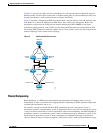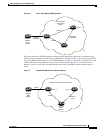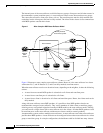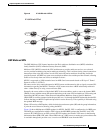
Implementing BGP on Cisco IOS XR Software
Information About Implementing BGP on Cisco IOS XR Software
RC-41
Cisco IOS XR Routing Configuration Guide
OL-14356-01
Figure 9 IP L3VPN with L2TPv3
BGP Multicast VPN
The BGP Multicast VPN feature introduces the IPv4 multicast distribution tree (MDT) subaddress
family identifier (SAFI) in Border Gateway Protocol (BGP).
Multicast VPN (MVPN) extends the VPN architecture to provide multicast services over a shared
service provider backbone using native multicast technology. This is achieved using virtual connections
between provider edge (PE) routers in each VPN and using native multicast forwarding inside the
provider network. An MDT may span across multiple customer sites and the provider network, allowing
traffic to flow freely from one source to multiple receivers.
MVPN is supported on VPN networks based on MPLS and on networks based on IP Layer 2 Tunnel
Protocol version 3 (L2TPv3).
PE routers are the only routers that must be MVPN-aware and that must be able to signal to remote PEs
information regarding the MVPN. Therefore, all PE routers must have a BGP relationship with each
other—either directly or using a route reflector (RR).
Generally the source address of the default MDT is the same address used to source the internal BGP
(IBGP) sessions with the remote PE routers that belong to the same VPN and multicast VPN routing and
forwarding (MVRF) instance. When Protocol Independent Multicast–Source Specific Multicast
(PIM–SSM) is used for transport inside the provider core, it is through the BGP relationship that the PEs
indicate that they are MVPN-capable and provide for source discovery. This capability is indicated using
the updated BGP message.
When a PE receives a BGP update, which includes the rendezvous point (RP) and the group information,
it joins the root of that tree, thereby joining the MDT.
Figure 10 shows Multiprotocol IBGP updates for MVPN. On PE1, PE2 is configured as its IBGP peer.
This BGP peer configuration within a VRF triggers the MP-IBGP updates that send PE1 local VPN
routes to PE2. BGP process on PE2 receives the VPN updates and installs VPN routes in the Routing
Information Base (RIB) VRF table. When PIM looks up a VRF source or rendezvous point address that
is reachable through the provider core, it receives an MP-IBGP route from the RIB.
VPN pink
IP L3VPN w/L2TPv3
CE-p1
VPN green
CE-g1
VPN green
CE-g2
PE2
BGP (RFC 4364)BGP (RFC 4364)
IP Network
VPN green
CE-g3
VPN pink
CE-p2
PE1
IPv4 Core
L2TPv3
VPN Label
VPN IP (from CE)
211300
PE3


















